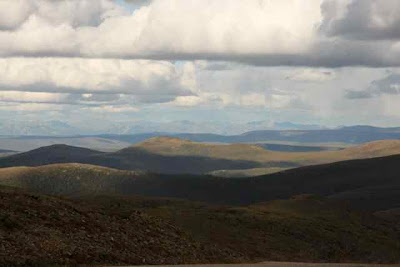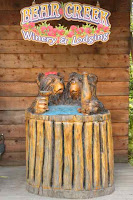One of my favorite hymns opens “All things bright and beautiful, all creatures great and small, all things wild and wonderful, the Lord God made them all.” To me, this song speaks the truth of Denali National Park.
We arrived in rain, of course… with spots of blue sky showing only briefly during our time there. It didn’t matter. Around every corner there was a surprise. Ultimately, it seemed as if mystery after mystery revealed itself to us.
On our first drive through the park, we spied two bull moose and caribou before returning to camp.
Feeling happy and carefree after an already productive photo shoot, I was busy getting things together for supper while David took a quick stroll to deposit garbage in the bear proof trash cans. A ground squirrel bravely munched pine cones at the base of the tree near our picnic bench under Rox's constant glare.
Suddenly, Roxanne’s nose went up, and she went into her alert stance. I figured that she had spied a neighbor dog and went to her to make certain that they would be friendly.
The dog looked odd on first glance, then my heart rushed. It was a fox! I knew that the camera was in the front seat of the truck. I ran to grab it and was able to snap off three shots of Rox and the fox eyeing each other. In a second, he trotted away. (Several days later, this same fox stole a GPS from a neighboring camp and walked away with it.)
Thus began our excursion to Denali. Off and on, the rain clouds would open to reveal rainbows. We easily chased a dozen of them. With each rainbow, I felt that God was telling me, “Just wait… there’s more that I want to show you.” I couldn’t wait to see what He had in store for me next!
Denali is closed to vehicles except for the first twelve miles. You can only travel deeper into the park on a shuttle tour bus. With Rox, we decided that we shouldn’t take a tour because the shortest one lasted five hours and the longest thirteen hours. A young ranger told us to contact a young lady named Rebecca who worked at the park. The next morning, God provided. Rebecca was the young lady we spoke with at the tour desk. She offered to care for Roxanne while we took the six hour tour to the Eielson Visitor Center, sixty-six miles into the park.
Still looking for that perfect bull moose shot, David and I drove into the park that evening. It was almost unbelievable… two grizzly bears were ravaging berries off bushes along Savage River. It was pouring rain. With a towel draped over the camera to keep it as dry as possible, we watched these magnificent beasts and wondered how things could possibly get any better.
With Rox receiving special care from Rebecca, we hopped the 6:30 shuttle bus the following morning. It misted rain most of the day, turning into downpours on occasion. Within the first hour of the bus tour, we spied three bears on the hillside. Later we saw a mother bear with two cubs. Still later, we saw a herd of Dall sheep. Then we saw a herd of nearly a hundred caribou gathering for migration. It was spectacular.

Not far from the visitor’s center, God gave me a gift I will never forget. A family of wolves played down in a meadow below Polychrome Pass, several hundred yards from us. Two adults ran as the pups nipped at their heels. They pounced on one another and chased each other. The bus driver stopped, allowing us to watch their play for nearly twenty minutes. I was absolutely mesmerized and must have taken nearly fifty shots with the long-range camera. Finally, I didn’t care if I got the perfect shot… I was nearly giddy just with the opportunity to watch their play.
As the tour continued, the rain increased. When we reached the visitor’s center, we were engulfed in fog. David and I figured that we would leave Denali seeing no more than a peek of Mount McKinley/Denali. Only thirty percent of all visitors get to see the mountain. Yet another rainbow greeted us the very moment that I had that thought.
About ten miles from our tour’s end, we spied three caribou males. One had an enormous rack still in velvet. The second appeared to be a yearling. The third’s rack dripped red with blood and freshly torn velvet as he readied himself for the coming rut. They were absolutely stunning.
Just a few miles more, and we saw a bull moose. The tour bus folks all laughed, joking with the driver about being able to summon up the “big five” (Dall sheep, bear, wolf, caribou, and moose) on the tour. I knew better. As confirmation, we turned the corner and saw another rainbow.
That night, David and I counted our blessings and surrendered to God’s glorious creation. We had seen the most spectacular display of animals in their natural habitat. It was okay if we hadn’t seen Mount McKinley/Denali. Nothing could surpass what we had already witnessed.
We awoke to overcast clouds and packed up to leave with happy hearts. Misty rain followed us through the park until one more rainbow appeared. We hit the valley along the south side of the Park’s highway… and the clouds parted… and there it was, Mount McKinley/Denali in all its glory.
“All things bright and beautiful, all creatures great and small, all things wild and wonderful, the Lord God made them all…”

















































